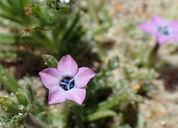Taxon Report
Gilia tenuiflora Benth. ssp. arenaria (Benth.) A. & V. GrantMonterey gilia |
 © 2021 Neal Kramer |
Taxon Summary
Gilia tenuiflora ssp. arenaria, commonly known as Monterey gilia, is a annual herb in the Polemoniaceae that is found only in California. It occurs within Chaparral (maritime), Cismontane woodland, Coastal dunes, and Coastal scrub, growing at elevations from 0 to 45 meters. Gilia tenuiflora ssp. arenaria is ranked 1B.2, Plants Rare, Threatened or Endangered in California and Elsewhere; Moderately threatened in California.Classification
|
Scientific Name: |
Gilia tenuiflora Benth. ssp. arenaria (Benth.) A. & V. Grant |
|
Common Name: |
Monterey gilia |
| Family: | Polemoniaceae |
| Element Code: | PDPLM041P2 |
| USDA Plants Symbol: | GITEA2 |
|
Synonyms/Other Names: |
|
Ecology and Life History
| Lifeform: | annual herb |
| Blooming Period: Apr-Jun | Apr-Jun |
| Elevation: | 0-45 (0-150) |
| General Habitats: | Chaparral, Cismontane woodland, Coastal dunes, Coastal scrub |
| Microhabitat: | Openings, Sandy |
| Microhabitat Details: |
Conservation Status
| CA Rare Plant Rank: | 1B.2 |
| Global Rank: | G3G4T2 |
|
State Rank: |
S2 |
| State List: | CT |
| Fed List: | FE |
| Other Status: | SB_CalBG/RSABG |
|
CRPR Changes: |
|
Occurrence Data from the CNDDB
| Total Occurrences: | 29 |
| Element Occurrence Ranks: | |
| Excellent (A) | 1 |
| Good (B) | 4 |
| Fair (C) | 5 |
| Poor (D) | 0 |
| None (X) | 4 |
| Unknown (U) | 15 |
| California Endemic: True | |
| California Counties and Islands: Name (Code) | |
| Monterey (MNT), Santa Cruz (SCR) | |
| Quads: Name (Quad Code) | |
| Marina (3612167), Monterey (3612158), Moss Landing (3612177), Salinas (3612166), Seaside (3612157), Spreckels (3612156), Watsonville West (3612187) | |
Threat List Data from the CNDDB
| Threat List Total: | 10 | |
| EOs with Threat Listed: | Total EOs | % of EOs |
| 18 | 62 % | |
| Development | 14 | 48% |
| Non-native plant impacts | 10 | 34% |
| ORV activity | 4 | 13% |
| Recreational use (non-ORV) | 4 | 13% |
| Foot traffic/trampling | 4 | 13% |
| Road/trail construction/maint. | 2 | 6% |
| Vandalism/dumping/litter | 1 | 3% |
| Landfill | 1 | 3% |
| Erosion/runoff | 1 | 3% |
| Biocides | 1 | 3% |
Citation
California Native Plant Society, Rare Plant Program. 2025. Rare Plant Inventory (online edition, v9.5.1). Website https://www.rareplants.cnps.org [accessed 17 December 2025].